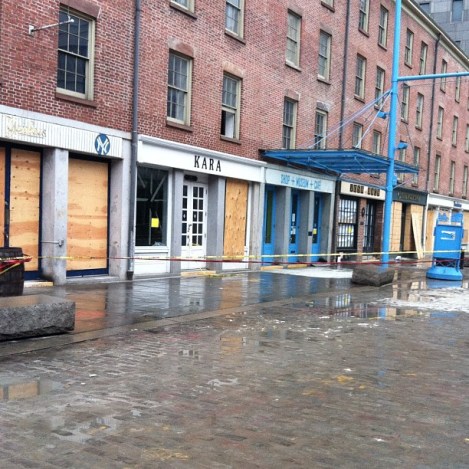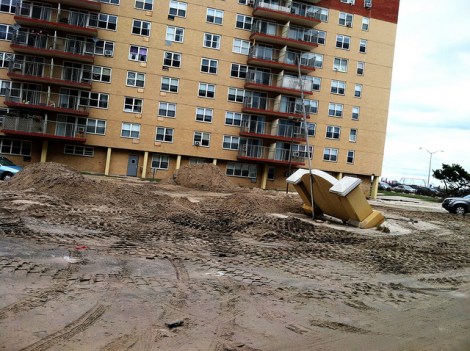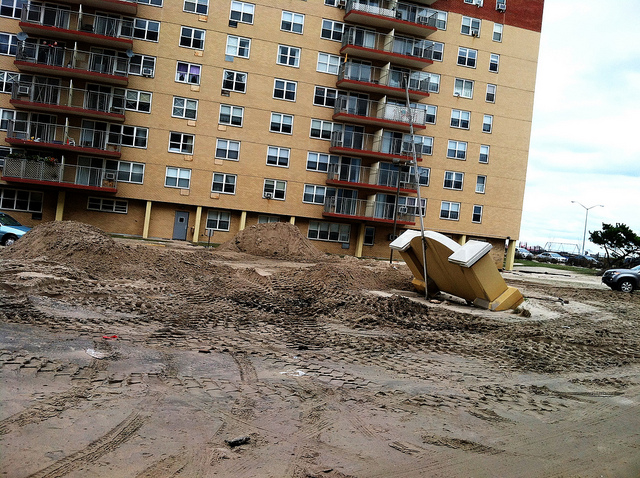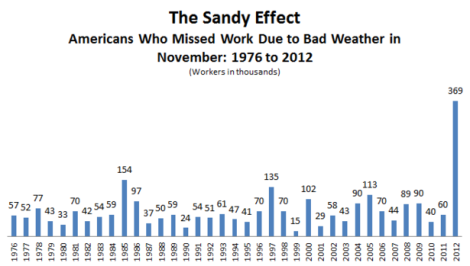Last Friday, the government released its first assessment of the nation’s employment since Hurricane Sandy. Surprisingly, the data suggested that the storm hadn’t had much impact on unemployment figures, a point called out by the Bureau of Labor Statistics. “[O]ur survey response rates in the affected states were within normal ranges,” the agency wrote. “Our analysis suggests that Hurricane Sandy did not substantively impact the national employment and unemployment estimates for November.”
Full state data comes out later this month, which may show a different picture for New York and New Jersey. There’s external evidence of an effect: New York Gov. Andrew Cuomo (D) suggests that the region saw 50,000 people in New York state lose jobs due to the storm and Moody’s says the number could be 86,000 across the region. The BLS’ data itself already shows an effect from the storm, as noted by Jordan Weissmann at The Atlantic. Here is a graph he created showing the number of people, in thousands, who missed work due to weather last month.
That’s more than twice any month prior.
The New York Times reported this weekend that the storm resulted in the complete loss of thousands of jobs in lower Manhattan — and that the negative economic effects of Sandy are ongoing.
There is no official tally, but local leaders estimated that a few thousand small businesses had been shuttered or were operating at less than full strength since the storm and that as many as 10,000 jobs had been lost, at least temporarily. About 3,000 apartments in Lower Manhattan remain uninhabitable, according to Daniel L. Squadron, a Democratic state senator who represents the area.
The Times describes one small business owner’s struggle.
Amanda Byron Zink has been trying to keep her dog-grooming business going even though her shop, the Salty Paw in South Street Seaport, could be washed out for months, and possibly for good. Ms. Zink and some of the groomers who worked in her shop have been operating temporarily from the basement of an animal hospital near the Seaport, but she said they “can only do little guys” because they only have a small sink to bathe the dogs in.
The Salty Paw was in the Historic Front Street development, which took on so much water that it will be closed for months. The complex of shops and apartments was powered by a set of geothermal wells drilled deep into the bedrock of Manhattan. The flood water, which Ms. Zink said rose to 11 feet in her ground-level salon, swamped the heating and electrical systems in the basement, she said.
Ms. Zink said she had received no payments from her insurance company even though she was covered for business interruption. Like most of the small businesses around hers, she had no flood insurance.

This is what the South Street Seaport looked like this weekend, six weeks after the storm.
Lower Manhattan is one of the more economically diverse areas of the city, the high-rises surrounding Wall Street within blocks of the historically low-income districts of Chinatown and the Lower East Side. As we mentioned last week, the area is also home to a number of large public housing complexes. In an exceptionally disturbing piece of reporting this morning, the Times also assessed the city’s far-too-slow efforts to meet the needs of low-income residents trapped in towers with no water or electricity. Even today, the problem persists in areas of the city closer to the ocean.
Hurricane Sandy put few agencies in the region to a more daunting test than it did the New York City Housing Authority — the nation’s biggest public landlord — as 402 of its buildings [PDF] housing 77,000 residents lost electricity and elevators, with most of them also losing heat and hot water. These lifelines were cut in some of the city’s most isolated spots, like Coney Island, Red Hook and the Rockaways.
An examination by The New York Times has found that while the agency moved aggressively before the storm to encourage residents to leave, particularly those who were disabled and the needy, both it and the city government at large were woefully unprepared to help its residents deal with Hurricane Sandy’s lingering aftermath.
The damage was immediate and extensive — as was evidence of the lack of preparation.
Around the city, 26 of the housing authority’s basement boiler rooms had flooded, destroying the equipment there, and leaving 34,565 apartments without heat and hot water. The electrical systems of many buildings, already in marginal shape because of delayed maintenance, were also devastated by flooding. Having power restored would not be enough: in about 95 buildings, temporary generators and boilers would be needed until the electrical systems could be rebuilt.
Water stopped flowing in many high-rise buildings above the sixth floor. Stairwells and hallways were pitch black. But because there was no up-to-date survey of electrical needs, the Army Corps of Engineers, called in to help install generators five days after the storm, first had to visit 100 authority buildings simply to determine what kind of generator each needed.
One senior advisor to the mayor largely placed the blame on the residents.
“We called for mandatory evacuation,” Howard Wolfson, another deputy mayor, said. “We did not do that assuming that the flood would reach someone on the 10th floor of a building — we did that because of some concern that there could well be outages of power, heat and water. Our hope, expectation and goal is people would leave these buildings.”

iakoubtchikA damaged hotel in the Rockaways.
Some city residents are now pre-evacuating areas that could be at risk in future storms. This morning, the New York Post reported on people moving out of the city’s Zone A, the area most at risk to flooding (though that zone designation is likely too small).
Asset Manager Greg Sperrazza, 25, had no choice but to look for another place after his luxury condo on 2 Gold St in the Financial District flooded with 31 feet of salt water, destroying the furnaces and back up generators. He’s looking to buy uptown because he thinks investing in property downtown is risky. …
And realtors are feeling the heat from desperate downtowners. Corcoran Vice President Victoria Terri-Cote said a recent open house for a one bedroom on sale for $869,000 on 71 East 77th Street drew in 15 people between the ages of 25 and 30 years old who after one week of crashing uptown decided it’s not that stuffy.
“Luxury condo.” “On sale for $869,000.” Those who are looking to move out of the most at-risk areas are, as always, those most capable of absorbing the economic shock, those with the means to move. If someone wasn’t able to temporarily evacuate his home with the storm bearing down on the city, the likelihood that he can spend three-quarters of a million dollars on a new place on the Upper East Side is slim.
The storm only made that prospect harder. Walking in lower Manhattan after the storm, it was stunning to see how the normally bustling streets of the area had become silent. The livelihoods of an uncountable number of people came to a sharp stop when the power went out. Even with it restored, the lack of phone service and a smaller customer base means economic disruption.
Sandy revealed the fragility of the livelihoods and housing of thousands of already at-risk residents. And the storm demonstrated that the government was ill-prepared to serve their needs immediately afterward — much less to develop strategies to ameliorate those risks in advance. President Obama has asked Congress to approve $60 billion in aid for the region. How much of that will go to those who were struggling before the storm is anyone’s guess.





